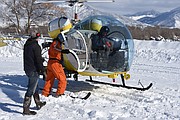Helicopter flights beginning for F&G surveys, studies
Beginning in December, Idaho Fish and Game staff will use low-flying helicopters to count deer and elk populations. Flights are scheduled across the state including the Panhandle region into March.
“These surveys provide crucial information to guide our management decisions,” Wildlife Manager Curtis Hendricks said. “Flying is not without risk, but it is how we provide accurate information to hunters about the health and distribution of our big game herds.”
Care is taken minimize disturbance to the animals and prevent the expenditure of valuable energy reserves. Generally, the information being collected can be gathered within a few minutes or less of an animal being spotted.
“There are some late-season hunts in progress during this time, and we are cognizant of that,” Hendricks said. “We will do our best to minimize the disturbance to hunters should we encounter them.”
In addition to surveys, the department will capture and collar hundreds of mule deer and elk throughout the state. Crews will then monitor the collared animals to get a better idea of herd survival through the winter and early spring.
The collars are made to expand as the animal grows and they are designed to track where an animal moves. With this information, biologists can learn about habitat use, seasonal movements, and perhaps most importantly, determine how many die and what caused their deaths.
A unique signal is produced if a collared animal is stationary for more than four hours, alerting biologists that the animal may be dead. In that event, crews head to the field to investigate the stationary collar, usually arriving in less than 48 hours.
If an the animal is dead, biologists collect clues such as age, body condition, bite marks and paw prints to determine how it died. Wolves, mountain lions and bears have different prey and feeding patterns. A sick deer or elk may have parasites or low fat stores.
The key is getting to the scene as early as possible, reducing the chance of scavengers and mixed clues.
If you see a helicopter circling in the skies at a low elevation in the Panhandle over the next few weeks, it may be a part of this study.



